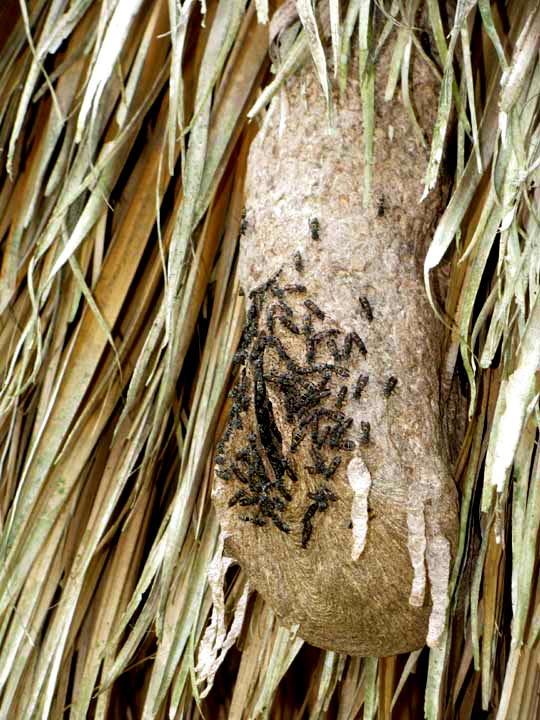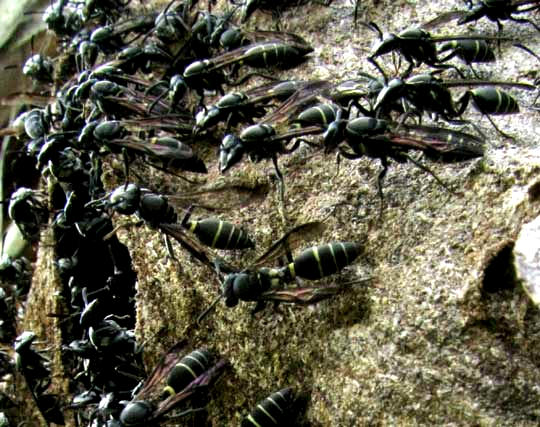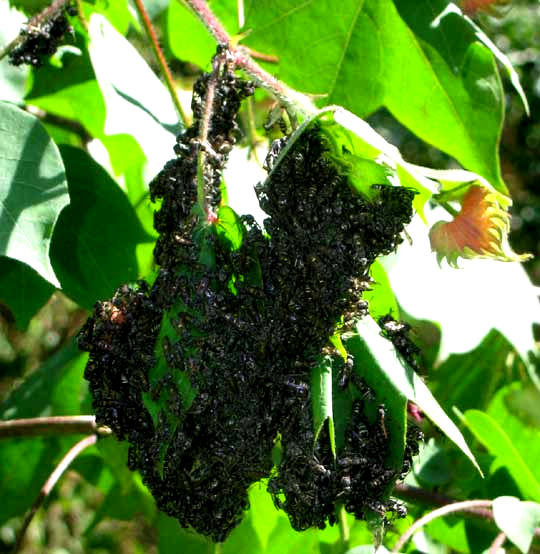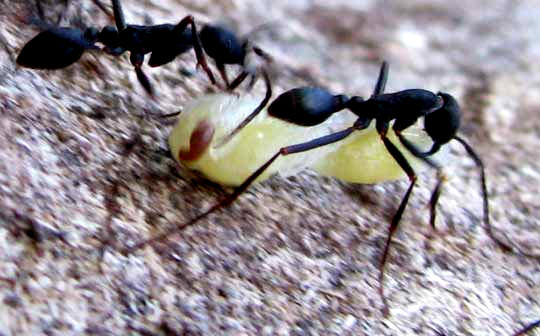Excerpts from Jim Conrad's
Naturalist Newsletter
from the December 11, 2011 Newsletter issued from Hacienda Chichen Resort beside Chichén Itzá Ruins; limestone bedrock; elevation ~39m (~128ft), N20.675°, W88.569°; central Yucatán state, MÉXICO
WASPS VS ANTS
When I arrived back at the hut about five weeks ago a new resident in the neighborhood nested in the hut's roof thatch about four feet east of the door, as seen below:

Upon my arrival the wasps were constructing the interior combs in which they'd raise their brood, but soon they began covering the combs with their coarse, gray paper made from chewed wood pulp. I watched the nest slowly take form day after day. You can see some wasps milling about their finished nest entrance below:

The wasps, which can deliver a moderately painful sting, never bothered me, always letting me stand close and watch, only occasionally darting at my face if I got too close, not stinging. The Maya, who accuse most reptiles and arthropods of every kind of devious and malicious intent to injury, admit that these wasps, which frequently live in their own hut thatch, hardly ever sting a hut's occupants. They say the wasps learn the hut owner's scent, and that only visitors need to take care.
And then about midday one day this week I returned to the hut to find a cloud of wasps buzzing around the nest, while on a Tree Cotton bush directly before the nest hundreds of them clustered as shown below:

If they'd been bees, I'd have thought that somehow already the little nest had produced a surplus population and now a new queen was leading part of the nest to someplace else where a new nest would be founded. However, I wasn't sure if wasps did that. I looked more closely at the nest.
The nest was swarming not with wasps but with ants. Fair sized ants poured out of the thatch, rushed across the nest's surface into the nest's teardrop-shaped entry hole, while others were already leaving the hole carrying white, paperlike flakes. The flakes were borne to the nest's bottom, where they were released into the air to flutter to the ground. Then the ants returned to the hole. At first I thought the flakes were wasp wings but up close I saw that they were the coverings of brood cells.
The wasp nest was being overrun by ants. Part of the wasps had escaped and now clustered on the Tree Cotton while the ants methodically tore apart the nest's interior chambers holding developing wasp pupae. Then ants began exiting the hole, not very tenderly dragging larvae beneath them, their sharp, ice-tong-like mandibles stuck into the pupae as shown below:

During this slaughter relative larger, red-headed soldier ants positioned themselves at the perimeter of action, their rear ends hunched beneath them as if they could sting, and their powerful mandibles open like incurved pincers ready to stab inwards, seen below:

In about half an hour the wasp swarm in the Tree Cotton departed. Until darkness fell the ants continued ripping open larval cells and carrying out white pupae, presumably to be butchered and distributed at their leisure.
The next morning the nest was empty, and quiet. During subsequent days from time to time wasps came and briefly surveyed the nest, but then flew away. Today the nest remains silent and abandoned.